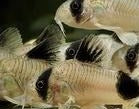Guaranteed Secured Checkout
The Panda Cory from Peru, where it is found in the Ucayali river system, the main headwater of the Amazon River.The region from which the panda cory originates is known for its blackwater conditions. The water is on the acidic side and quite soft due to lack of minerals. Additionally, these waters are a bit cooler than other tropical areas, running in the mid to low 20s on average.
The body of the panda cory is off-white to faint pink in colour, with three prominent deep black markings. The first begins at the top of the head and covers the eyes, much like the black markings around the eyes of a giant panda. The second black marking covers the dorsal fin, and the third is at the base of the tail, known as the caudal peduncle. The size of this third spot at the base of the tail varies and has given rise to the big-spot and small-spot morphs of this fish, each being named for the size of the tail spot.
Like other members of the cory family, this fish has two rows of overlapping bony plates known as scutes, rather than scales. Panda corys have three sets of paired barbels, as well as several sharp barbs that serve as a defense mechanism. One barb is located under each eye, another in front of the dorsal fin, and another on the adipose fin. Adults can grow up to two inches in length, but quite often they remain smaller than that.
Panda corys are extremely peaceful fish that enjoy the company of their own kind. They should always be kept in groups, preferably of a half-dozen or more, but at least three or four if space is limited. Pandas corys are highly social and are known to tag along with other bottom-dwelling species, most notablyclown loaches.
Although they get along well with virtually all species, it is not wise to keep them with large or overly boisterous fish that might pick on them or appear to be threatening. Tiger barbs, for example, are not a good companion due to their tendency to nip at other fish. Small to medium sized tetras, danios, and rasboras are good companions for panda corys. Other small catfish such as aspidoras, as well as any cory species, are also suitable
The substrate should be soft and fine, either fine gravel or sand. Live plants are ideal, but not required as long as there is plenty of decoration that provides shade and hiding places. Caves, rocks, and driftwood all are excellent ways to make this catfish feel comfortable and at home. Floating plants, either real or artificial are helpful to provide shade.
Panda corys are great scavengers that snap up any food that falls to the bottom. However, if housed in a community tank with other fish, care should be taken to ensure that sufficient food reaches the bottom of the tank for the corys. Sinking food tablets or pellets are a great option. A varied diet is important for optimal health. Include meaty foods when possible, either live or frozen. Shrimp, worms, insects, and any crustaceans are good choices. They seem to be particularly fond of bloodworms, brine shrimp, and daphnia. Several prepared food tablets are formulated specifically for corys and are a great food choice for panda corys. Keep in mind that this species is active at night, so consider dropping a few food tablets in the tank just before turning off the lights for the night.
The female panda cory is larger and has a more rounded underbelly, and is much wider than the male when viewed from above. Often the rounded belly of the female causes their head to sit a bit off the bottom of the tank. Makes are more sleek and shorter in length than the females.



